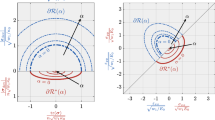Abstract
In this expository Note, it is shown that the Griffith phase-field theory of fracture accounting for material strength originally introduced by Kumar, Francfort, and Lopez-Pamies (J Mech Phys Solids 112, 523–551, 2018) in the form of PDEs can be recast as a variational theory. In particular, the solution pair \((\textbf{u},v)\) defined by the PDEs for the displacement field \(\textbf{u}\) and the phase field v is shown to correspond to the fields that minimize separately two different functionals, much like the solution pair \((\textbf{u},v)\) defined by the original phase-field theory of fracture without material strength implemented in terms of alternating minimization. The merits of formulating a complete theory of fracture nucleation and propagation via such a variational approach — in terms of the minimization of two different functionals — are discussed.
Similar content being viewed by others
Data Availability
No datasets were generated or analysed during the current study.
Notes
We will come back to the more general case of non-monotonic and dynamic loading conditions in Section 4 below.
A FEniCS code of the resulting phase-field theory is available in GitHub: https://github.com/farhadkama/FEniCSx_Kamarei_Kumar_Lopez-Pamies.
“Large” refers to large relative to the characteristic size of the underlying heterogeneities in the solid under investigation. By the same token, “small” refers to sizes that are of the same order or just moderately larger than the sizes of the heterogeneities. In practice, as a rule of thumb, “large” refers to large relative to the material length scale \(G_c/\mathcal {W}_{\texttt {ts}}\).
References
Bourdin B, Francfort GA, Marigo JJ (2000) Numerical experiments in revisited brittle fracture. J Mech Phys Solids 48:797–826
Bourdin B, Francfort GA, Marigo JJ (2008) The variational approach to fracture. J Elast 91:5–148
Drucker DC, Prager W (1952) Soil mechanics and plastic analysis for limit design. Q Appl Math 10:157–165
Fichera G (1973) Existence Theorems in Elasticity. In: Truesdell C (ed) Linear Theories of Elasticity and Thermoelasticity. Springer, Germany
Francfort GA, Marigo JJ (1998) Revisiting brittle fracture as an energy minimization problem. J Mech Phys Solids 46:1319–1342
Griffith AA (1921) The phenomena of rupture and flow in solids. Philos Trans R Soc London. Series A 221:163–198
Kamarei F, Kumar A, Lopez-Pamies O (2024). The poker-chip experiments of synthetic elastomers explained. Submitted
Kumar A, Lopez-Pamies O (2020) The phase-field approach to self-healable fracture of elastomers: A model accounting for fracture nucleation at large, with application to a class of conspicuous experiments. Theo Appl Fract Mech 107:102550
Kumar A, Lopez-Pamies O (2021) The poker-chip experiments of Gent and Lindley (1959) explained. J Mech Phys Solids 150:104359
Kumar A, Francfort GA, Lopez-Pamies O (2018a) Fracture and healing of elastomers: A phase-transition theory and numerical implementation. J Mech Phys Solids 112:523–551
Kumar A, Ravi-Chandar K, Lopez-Pamies O (2018b) The configurational-forces view of fracture and healing in elastomers as a phase transition. Int J Fract 213:1–16
Kumar A, Bourdin B, Francfort GA, Lopez-Pamies O (2020) Revisiting nucleation in the phase-field approach to brittle fracture. J Mecha Phys Solids 142:104027
Kumar A, Ravi-Chandar K, Lopez-Pamies O (2022) The revisited phase-field approach to brittle fracture: Application to indentation and notch problems. Int J Fract 237:83–100
Kumar A, Liu Y, Dolbow JE, Lopez-Pamies O (2024) The strength of the Brazilian fracture test. J Mech Phys Solids 182:105473
Larsen CJ (2021) Variational fracture with boundary loads. Appl Math Lett 121:107437
Larsen CJ (2023) Variational phase-field fracture with controlled nucleation. Mech Res Commun 128:104059
Liu C, Kumar A (2024). Emergence of tension-compression asymmetry from a complete phase-field approach to brittle fracture. Submitted
Lopez-Pamies O (2023) Journal Club: Strength revisited: One of three basic ingredients needed for a complete macroscopic theory of fracture. https://imechanica.org/node/26641
Acknowledgements
Support for this work by the National Science Foundation through the Grants DMS–2206114 and DMS–2308169 is gratefully acknowledged. This work began during the 2024 workshop “Fracture as an emergent phenomenon” at the Mathematisches Forschungsinstitut Oberwolfach, who we thank for hosting us.
Author information
Authors and Affiliations
Contributions
Christopher J. Larsen: Conceptualization, Formal analysis, Writing – review & editing. John E. Dolbow: Writing – review & editing. Oscar Lopez-Pamies: Conceptualization, Formal analysis, Writing – original draft, Writing – review & editing.
Corresponding author
Ethics declarations
Conflict of interest
The authors declare no Conflict of interest.
Additional information
Publisher's Note
Springer Nature remains neutral with regard to jurisdictional claims in published maps and institutional affiliations.
Rights and permissions
Springer Nature or its licensor (e.g. a society or other partner) holds exclusive rights to this article under a publishing agreement with the author(s) or other rightsholder(s); author self-archiving of the accepted manuscript version of this article is solely governed by the terms of such publishing agreement and applicable law.
About this article
Cite this article
Larsen, C.J., Dolbow, J.E. & Lopez-Pamies, O. A variational formulation of Griffith phase-field fracture with material strength. Int J Fract (2024). https://doi.org/10.1007/s10704-024-00786-3
Received:
Accepted:
Published:
DOI: https://doi.org/10.1007/s10704-024-00786-3




